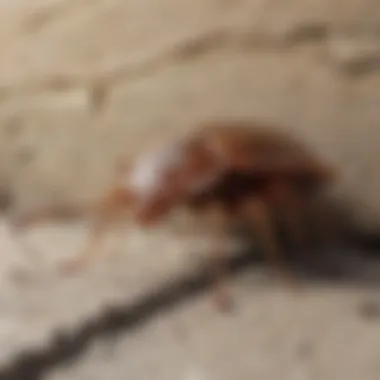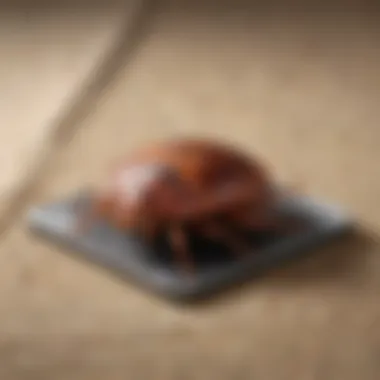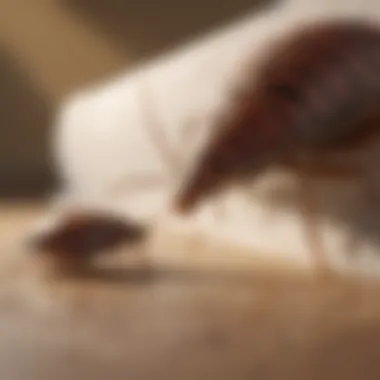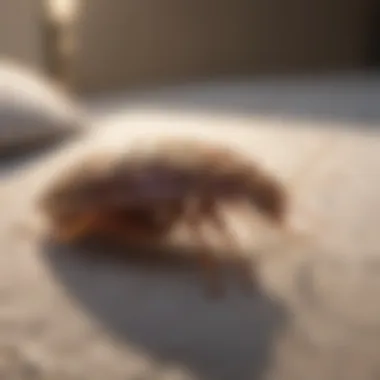Drawing Out Bed Bugs: A Comprehensive Guide to Eliminating Infestations


Preventive Pest Control Strategies
Pest control is essential for maintaining a healthy and pest-free home environment. Implementing preventive strategies can significantly reduce the risk of infestations and ensure a comfortable living space for you and your family. Let's delve into some crucial preventive pest control measures to help you safeguard your home.
House Exterior Protection
Protecting the exterior of your house is the first line of defense against pest invasions. Start by inspecting and sealing any cracks or gaps around windows, doors, and foundations. This will help prevent pests like bed bugs from finding their way indoors. Clearing debris such as leaves and wood piles can also eliminate hiding spots for pests and reduce the likelihood of infestations. Additionally, consider installing screens on doors and windows to prevent pests from entering your home.
Yard Maintenance
Maintaining a well-kept yard is another key aspect of pest control. Regularly mowing the grass, trimming bushes, and removing any standing water can help prevent pests from breeding and thriving in your yard. Consider using insect-repelling plants or natural remedies to deter pests from making your yard their home.
Indoor Cleanliness
Indoor cleanliness is crucial in preventing pests from establishing infestations. Regularly vacuuming, dusting, and decluttering can help eliminate potential hiding spots for pests. Pay special attention to areas like kitchens and bathrooms, as these are common hotspots for pests. Consider using sealed containers for food storage and keeping pet areas clean to reduce the attraction of pests.
Garbage Disposal
Proper garbage disposal is paramount in keeping pests at bay. Make sure to securely seal garbage bags and dispose of them regularly in closed bins. Avoid leaving trash bags lying around or overflowing bins, as this can attract pests looking for food sources.
Other Pest Prevention Strategies
In addition to the mentioned strategies, there are other innovative ways to safeguard your home from pest infestations. Consider using natural repellents like peppermint oil or diatomaceous earth to deter pests. Installing door sweeps and repairing torn window screens can also prevent pests from sneaking in through gaps. By combining these preventive measures, you can create a hostile environment for pests and protect your home effectively.
Understanding Bed Bugs
Bed bugs are a common household pest that can cause significant problems if left unchecked. Understanding the behavior, biology, and characteristics of bed bugs is crucial in effectively combating infestations. In this article, we delve deep into the intricacies of bed bugs, providing insights that will empower you to identify, prevent, and eradicate these unwanted visitors from your living spaces.


Identifying Bed Bugs
Physical Characteristics of Bed Bugs
When it comes to identifying bed bugs, their physical characteristics play a pivotal role. Bed bugs are small, reddish-brown insects with oval-shaped bodies. They lack wings, but their bodies are flattened, allowing them to hide in cracks and crevices easily. The key characteristic of bed bugs lies in their ability to feed on blood, primarily from humans. This feature makes them a significant concern for homeowners as their bites can cause irritation and discomfort. Despite their small size, bed bugs are resilient pests that can multiply rapidly if not addressed promptly. Understanding their physical appearance is essential for early detection and effective control measures.
Common Hiding Spots
Knowing where bed bugs hide is essential for thorough inspections and targeted treatment. These pests typically seek out dark, secluded areas to nest and reproduce. Common hiding spots include mattress seams, bed frames, furniture joints, electrical outlets, and baseboards. The key characteristic of these hiding spots is their proximity to areas where hosts rest or sleep, providing easy access for feeding. While bed bugs can thrive in various environments, they prefer locations close to their food source, i.e., humans. Identifying these common hiding spots is vital for implementing comprehensive eradication strategies and preventing infestations from worsening.
Lifecycle of Bed Bugs
Egg Stage
The lifecycle of bed bugs consists of several stages, starting with the egg stage. Bed bug eggs are tiny, translucent, and roughly the size of a pinhead. They are usually laid in clusters and have a sticky coating that adheres to surfaces. The key characteristic of bed bug eggs is their resilience to insecticides and environmental factors, making them challenging to eradicate. Despite their small size, bed bug eggs are crucial in perpetuating infestations, as they hatch into nymphs within about a week. Understanding the egg stage is critical for targeted treatment regimens that address all life stages of bed bugs.
Nymph Stage
As bed bug eggs hatch, nymphs emerge and undergo several molts before reaching adulthood. Nymphs are smaller than adults and nearly colorless, becoming darker as they feed on blood. The key characteristic of nymphs is their heightened mobility and feeding frequency compared to adults, as they require regular blood meals to molt into the next stage. Nymphs can hide in tiny cracks and crevices, making them challenging to detect without thorough inspection. Identifying nymphs early in the infestation is essential for controlling population growth and preventing widespread infestations.
Adult Stage
Adult bed bugs are approximately the size of an apple seed and exhibit distinct reddish-brown coloration. They have well-developed mouthparts for feeding and can survive several months without blood. The key characteristic of adult bed bugs is their mating behavior and reproductive capacity, with females laying multiple eggs daily. Adults prefer to hide near hosts for convenient feeding opportunities, making bedrooms and living areas prime locations for infestations. Understanding the behavior and habits of adult bed bugs is crucial for implementing targeted eradication methods that disrupt their life cycle and prevent reinfestation.
Signs of Bed Bug Infestation
This section delves into the vital topic of Signs of Bed Bug Infestation within the comprehensive guide,


Preventive Measures
Preventive measures play a crucial role in ensuring a bed bug-free environment. By proactively implementing preventative strategies, you can mitigate the risk of bed bug infestations and maintain a clean living space. In this section, we will delve into two key elements of preventive measures: keeping a clean environment and sealing entry points.
Keep a Clean Environment
Maintaining a clean environment is fundamental in preventing bed bug infestations. Regular Vacuuming is a cornerstone of this practice. Regular vacuuming not only helps in removing potential bed bugs and their eggs but also eliminates debris and dirt that may serve as hiding spots. The suction power of a vacuum cleaner effectively picks up bed bugs from various surfaces, including carpets, upholstery, and crevices. This meticulous cleaning process aids in reducing the bed bug population and interrupting their life cycle.
Another critical aspect of keeping a clean environment is Clutter Control. Clutter provides ample hiding spots for bed bugs, making it challenging to detect and eliminate infestations. By decluttering living spaces, you remove hiding spots and reduce the likelihood of bed bug infestations. Adopting a clutter-free approach not only promotes a healthier living environment but also enhances the effectiveness of pest control measures.
Sealing Entry Points
Sealing entry points is a proactive measure to prevent bed bugs from infiltrating your home. Caulking Cracks and Crevices is an essential practice to seal off potential entry points for bed bugs. Caulk is a sealant applied to cracks and crevices in walls, baseboards, and furniture to prevent bed bugs from entering or escaping. By sealing these openings, you create a barrier that inhibits the movement of bed bugs and reduces the chances of infestation. Caulking serves as a long-term solution in fortifying your home against bed bug intrusion.
Utilizing Door Sweeps is another effective method to seal entry points and prevent bed bug ingress. Door sweeps are weather stripping devices installed at the base of doors to seal the gap between the door and the floor. This physical barrier inhibits the entry of bed bugs through gaps and ensures a tight seal. Door sweeps not only prevent bed bugs from entering but also contribute to energy efficiency by reducing drafts and maintaining indoor temperature. Incorporating door sweeps as part of your pest management strategy enhances the overall protection of your living spaces.
Natural Remedies for Bed Bugs
Natural remedies play a crucial role in the effective eradication of bed bugs from your living spaces. In this comprehensive guide, we shed light on specific elements, benefits, and considerations surrounding natural remedies for bed bugs that can aid you in maintaining a pest-free environment.
Essential Oils
Lavender Oil:
Exploring Lavender Oil's role in combating bed bugs is essential. Lavender oil is renowned for its potent scent, which acts as a natural repellent against these pests. The key characteristic of Lavender Oil lies in its soothing aroma that not only combats bed bugs but also promotes a calming ambiance in your home. Its advantage in this article is its dual-purpose nature as a repellent and mood booster. However, one consideration to note is that while effective, Lavender Oil's fragrance might not be suitable for everyone.
Tea Tree Oil:


Moving on to Tea Tree Oil, this essential oil is a powerhouse in bed bug control. Its strong, medicinal scent serves as a deterrent for bed bugs, making it a popular choice for natural pest control. The key characteristic of Tea Tree Oil is its antimicrobial properties, which not only repel bed bugs but also disinfect the area. Its advantage lies in its versatility for both pest control and health benefits. One consideration is that Tea Tree Oil has a potent odor, which may not appeal to all individuals.
Diatomaceous Earth
Application Methods:
Diatomaceous Earth's application methods are vital for effectively eliminating bed bugs. The key characteristic of its application lies in its abrasive nature, which punctures the bed bug's exoskeleton, leading to dehydration and ultimately their demise. This method is not only effective but also eco-friendly, making it a popular choice for environmentally conscious individuals. Its advantage in this article is its non-toxic approach to pest control. However, one consideration to bear in mind is that proper application is crucial for optimal results.
Effectiveness:
The effectiveness of Diatomaceous Earth in eradicating bed bugs is unparalleled. Its key characteristic is its long-lasting impact on bed bug populations, ensuring a thorough elimination process. This method's advantage is its residual effects, continuing to work long after initial application. One consideration is that while highly effective, patience is required as it may take some time to see full results.
Professional Treatment Options
In the realm of bed bug extermination, professional treatment options stand out as a crucial aspect of combatting infestations effectively. These services bring a level of expertise and sophistication that surpasses DIY methods, ensuring thorough eradication and prevention of future occurrences. By enlisting pest control specialists, homeowners can benefit from their in-depth knowledge of bed bug behavior, lifecycle, and optimal treatment strategies. The professional touch not only eliminates existing bed bugs but also devises proactive measures to safeguard against reinfestation, thus guaranteeing a long-term pest-free environment.
Pest Control Services
Inspection Procedures
The cornerstone of any successful pest control service is the meticulous inspection procedures employed. These procedures involve a systematic and comprehensive assessment of the infested area, identifying not only the presence of bed bugs but also their nesting sites and extent of infestation. By delving deep into the nooks and crannies where bed bugs hide, professionals can effectively tailor treatment plans to target the root cause of the infestation. Inspection procedures play a critical role in the success of bed bug extermination efforts, providing vital information for devising targeted and efficient treatment strategies.
Treatment Plans
Once the inspection phase is complete, pest control services devise custom treatment plans based on the specific needs of the infested property. These plans take into account factors such as the severity of infestation, type of dwelling, and any other relevant considerations. By tailoring treatment approaches to each unique situation, professionals can ensure optimal results with minimal disruption. Treatment plans may incorporate a combination of strategies such as chemical treatments, heat treatments, and ongoing monitoring to eliminate bed bugs comprehensively and prevent future recurrences.
Heat Treatment
Process Overview
Heat treatment emerges as a popular and effective approach to eradicating bed bugs due to its non-toxic nature and ability to reach deep into furniture, crevices, and other hard-to-reach spots. The process involves raising the temperature within the infested area to levels lethal to bed bugs while being safe for humans and pets. This method ensures that all life stages of bed bugs, from eggs to adults, are eradicated, leaving no chance for survival or reinfestation.
Advantages
The advantages of heat treatment are manifold, making it a preferred option for many homeowners facing bed bug infestations. Apart from being chemical-free and environmentally friendly, heat treatment is also quick, with the ability to eliminate bed bugs in a single treatment session. Furthermore, the high success rate of heat treatment in eradicating bed bugs, coupled with minimal preparation and re-entry times, enhances its appeal as a fast and efficient extermination method.



